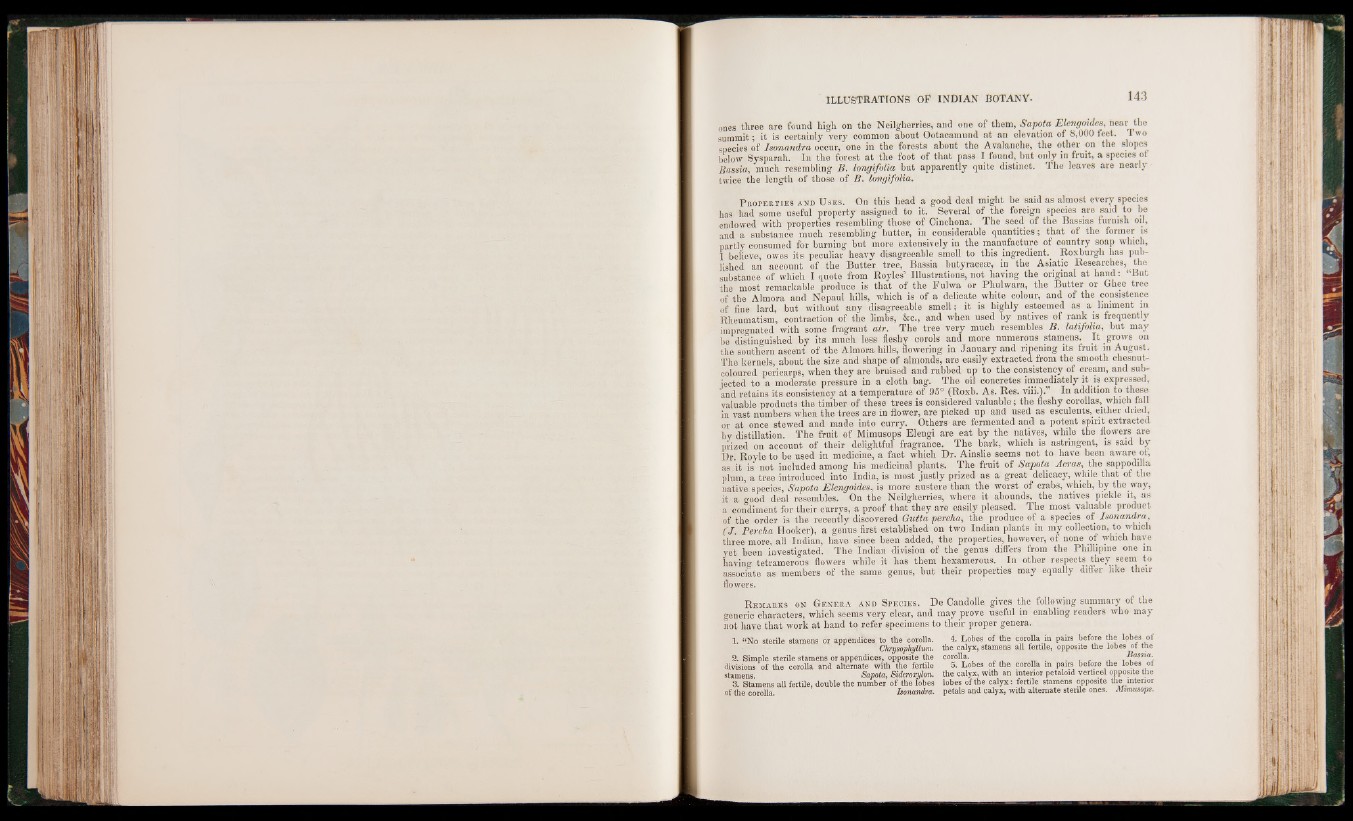
ones three are found high on the Neilgherries, and one of them, Sapota Elengoides, near the
summit; it is certainly very common about Ootacamund at an elevation of 8,000 feet. Two
species of Isonandra occur, one in the forests about the Avalanche, the other on the slopes
below Sysparah. In the forest at the foot of that pass I found, but only in fruit, a species of
Bassia, much resembling B. longifolia but apparently quite distinct. The leaves are nearly
twice the length of those of B. longifolia.
P roperties and U ses. On this head a good deal might be said as almost every species
has had some useful property assigned to it. Several of the foreign species are said to be
endowed with properties resembling those of Cinchona. The seed of the Bassias furnish oil,
and a substance much resembling butter, in considerable quantities; that of the former is
partly consumed for burning but more extensively in the manufacture of country soap which,
I believe, owes its peculiar heavy disagreeable smell to this ingredient. Roxburgh has published
an account of the Butter tree, Bassia butyracese, in the Asiatic Researches, the
substance of which I quote from Royles’ Illustrations, not having the original at hand: “But
the most remarkable produce is that of the Pulwa or Phulwara, the Butter or Ghee tree
of the Almora and Nepaul hills, which is of a delicate white colour, and of the consistence
of fine lard, but without any disagreeable smell; it is highly esteemed as a liniment in
Rheumatism, contraction of the limbs, &c., and when used by natives of rank is frequently
impregnated with some fragrant atr. The tree very much resembles B. latifolia, but may
be distinguished by its much less fleshy corols and more numerous stamens. It grows on
the southern ascent of the Almora hills, flowering in January and ripening its fruit in August.
The kernels, about the size and shape of almonds, are easily extracted from the smooth chesnut-
coloured pericarps, when they are bruised and rubbed up to the consistency of cream, and subjected
to a moderate pressure in a cloth bag. The oil concretes immediately it is expressed,
and retains its consistency at a temperature of 95° (Roxb. As. Res. viii.).” In addition to these
valuable products the timber of these trees is considered valuable; the fleshy corollas, which fall
in vast numbers when the trees are in flower, are picked up and used as esculents, either dried,
or at once stewed and made into curry. Others are fermented and a potent spirit extracted
by distillation. The fruit of Mimusops Elengi are eat by the natives, while the flowers are
prized on account of their delightful fragrance. The bark, which is astringent, is said by
4-, -r. i i __________ ___ A in o lin c sn am a n u t t n lio i/P npAn flT.
native species, Sapota Elengoides, __----- . . . -
it a good deal resembles. On the Neilgherries, where it abounds, the natives pickle it, as
a condiment for their cUrrys, a proof that they are easily pleased. The most valuable product
of the order is the recently discovered Gutta pereha, the produce of a species of Isonandra,
(J. Pereha Hooker), a genus first established on two Indian plants in my collection, to which
three more, all Indian, have since been added, the properties, however, of none of which have
yet been investigated. The Indian division of the genus differs from the Phillipine one m
having tetramerous flowers while it has them hexamerous. In other respects they seem to
associate as members of the same genus, but their properties may equally differ like their
flowers.
R emarks on Genera and Species. De Candolle gives the following summary of the
generic characters, which seems very clear, and may prove useful in enabling readers who may
not have that work at hand to refer specimens to their proper genera.
1. “No sterile stamens or appendices to the corolla.
Ckrysophjllum.
2. Simple sterile stamens or appendices, opposite the
divisions of the corolla and alternate with the fertile
stamens. Sapota, Sideroxylon.
3. Stamens all fertile, double the number of the lobes
of the corolla. Isonandra.
4. Lobes of the corolla in pairs before the lobes of
the calyx, stamens all fertile, opposite the lobes of the
corolla. | Bassia.
5. Lobes of the corolla in pairs before the lobes of
the calyx, with an interior petaloid verticel opposite the
lobes of the calyx: fertile stamens opposite the interior
petals and calyx, with alternate sterile ones. Mimusops.